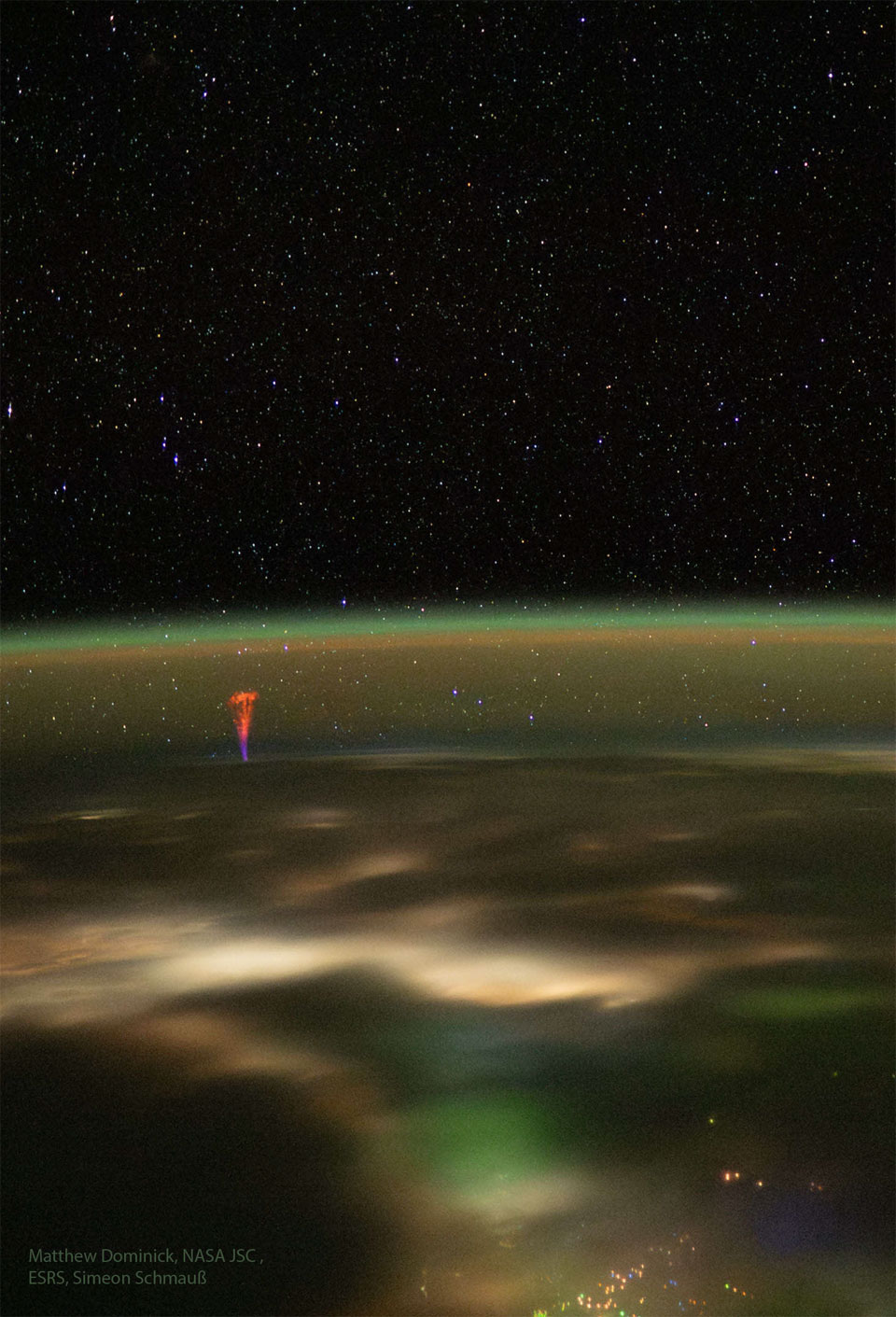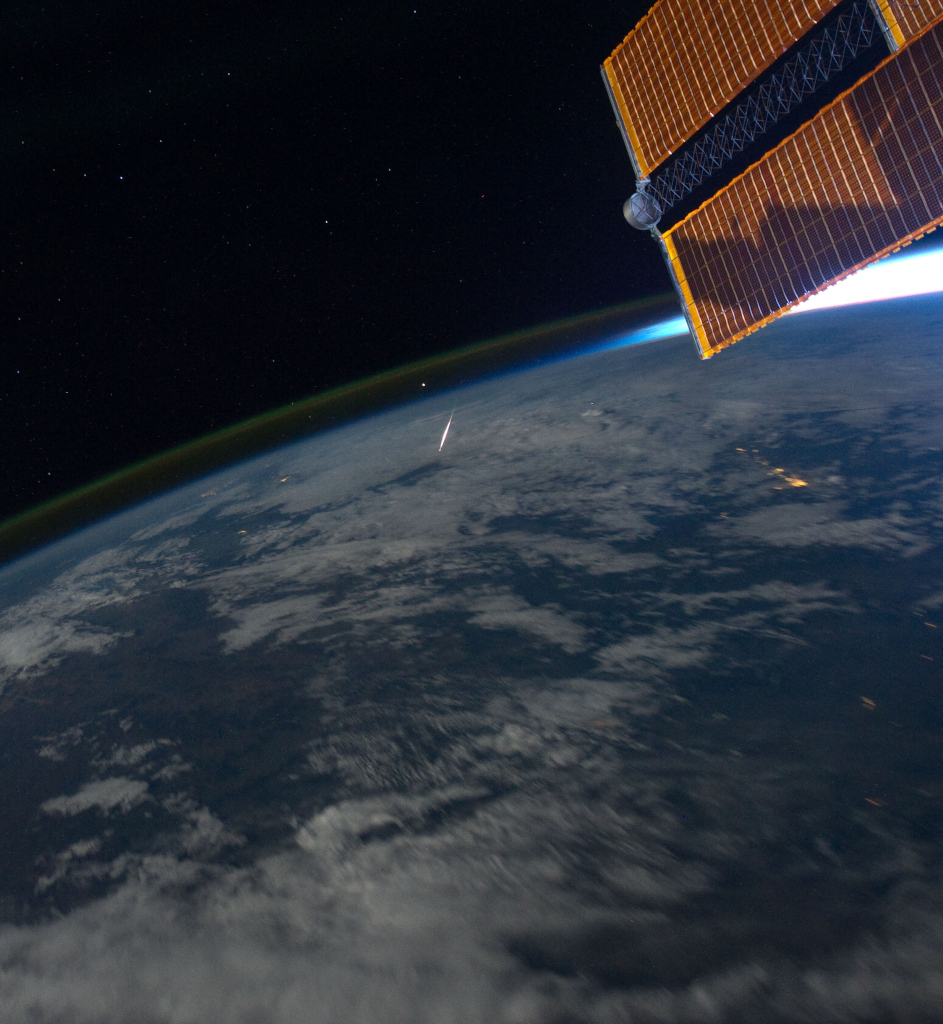Nombre total de pages vues
13/08/2024
INVENTIONS DE DEMAIN - Un catalogue complet des mutations génétiques
ASTRONOMY - Giant Jet from the International Space Station
2024 August 13
Image Credit: NASA, Expedition 71 Crew, JSC, ESRS, Matthew Dominick; Processing: Simeon Schmauß
Explanation: What's that on the horizon? When circling the Earth on the International Space Station early last month, astronaut Matthew Dominick saw an unusual type of lightning just beyond the Earth's edge: a gigantic jet. The powerful jet appears on the left of the featured image in red and blue. Giant jet lightning has only been known about for the past 23 years. The atmospheric jets are associated with thunderstorms and extend upwards towards Earth's ionosphere. The lower part of the frame shows the Earth at night, with Earth's thin atmosphere tinted green from airglow. City lights are visible, sometimes resolved, but usually creating diffuse white glows in intervening clouds. The top of the frame reveals distant stars in the dark night sky. The nature of gigantic jets and their possible association with other types of Transient Luminous Events (TLEs) such as blue jets and red sprites remains an active topic of research.
12/08/2024
SANTé/MEDECINE - Voici une technique naturelle pour lutter contre les piqures de moustiques
Démangeaisons : La réaction allergique à la salive du moustique peut provoquer des démangeaisons intenses autour de la zone piquée.
Rougeurs et gonflements : La peau autour de la piqûre peut devenir rouge, enflée et chaude au toucher.
Irritations cutanées : Les piqûres de moustiques peuvent causer des irritations cutanées, des plaques rouges ou des réactions cutanées locales.
Infections : En se grattant les piqûres, il est possible de provoquer des lésions cutanées qui peuvent s'infecter.
Réactions allergiques : Certaines personnes peuvent être plus sensibles aux piqûres de moustiques et développer des réactions allergiques plus graves, telles que des œdèmes, des éruptions cutanées généralisées, des difficultés respiratoires, etc.
Transmission de maladies : Dans certaines parties du monde, les moustiques peuvent transmettre des maladies comme le paludisme, la dengue, le virus du Nil occidental, le chikungunya, etc. Ces maladies peuvent avoir des conséquences graves pour la santé.
Sur son compte Instagram, une influenceuse a donné une astuce imparable : "Saviez-vous que vous pouvez utiliser une peau de banane pour soulager les démangeaisons causées par une piqûre de moustique ? Cela est dû aux huiles naturelles présentes dans la peau de banane. Frottez simplement la peau de banane côté chair vers le bas contre votre morsure et les démangeaisons disparaîtront progressivement", a-t-elle écrit.
Il est important de surveiller attentivement les piqûres de moustiques et de suivre les recommandations médicales si des symptômes graves ou persistants apparaissent. Pour soulager les symptômes des piqûres de moustiques, des remèdes locaux comme des crèmes antiprurigineuses, des compresses froides, des lotions apaisantes ou des médicaments antihistaminiques peuvent être utilisés.
Il existe d’autres moyens efficaces de se débarrasser des piqures de moustiques. Par exemple, les répulsifs à base de DEET, d'icaridine ou d'huiles essentielles comme la citronnelle ou l'eucalyptus peuvent être efficaces pour repousser les moustiques. Les vêtements qui couvrent la peau et de couleur claire peuvent aussi aider à réduire les risques de piqûres de moustiques. Il est recommandé d'installer des moustiquaires aux fenêtres, portes et lits pour empêcher les moustiques de pénétrer dans les espaces de vie.
Évitez également les endroits où les moustiques sont plus présents, comme les zones humides, les marais ou les lieux où l'eau stagnante est présente. Les moustiques sont plus actifs à l'aube et au crépuscule, il est donc préférable d'éviter de sortir à ces moments-là si possible. En suivant ces conseils, vous pouvez minimiser les risques de piqûres de moustiques et réduire les désagréments associés à ces incidents.
Léa Ouzan
ASTRONOMY - Perseid Meteors over Stonehenge
2024 August 12
Image Credit & Copyright: Josh Dury
Explanation: What's happening in the sky above Stonehenge? A meteor shower: specifically, the Perseid meteor shower. A few nights ago, after the sky darkened, many images of meteors from this year's Perseids were captured separately and merged into a single frame. Although the meteors all traveled on straight paths, these paths appear slightly curved by the wide-angle lens of the capturing camera. The meteor streaks can all be traced back to a single point on the sky called the radiant, here just off the top of the frame in the constellation of Perseus. The same camera took a deep image of the background sky that brought up the central band of our Milky Way galaxy running nearly vertical through the image center. The featured image was taken from Wiltshire, England, being careful to include, at the bottom, the famous astronomical monument of Stonehenge. Although the Perseids peaked last night, some Perseid meteors should still be visible for a few more nights.
11/08/2024
ASTRONOMIE - Les étoiles filantes des Perséides en août 2024
ASTRONOMY - Animation: Perseid Meteor Shower
2024 August 11
Visualization Credit: Ian Webster; Data: NASA, CAMS, Peter Jenniskens (SETI Institute)
Explanation: Where do Perseid meteors come from? Mostly small bits of stony grit, Perseid meteoroids were once expelled from Comet Swift-Tuttle and continue to follow this comet's orbit as they slowly disperse. The featured animation depicts the entire meteoroid stream as it orbits our Sun. When the Earth nears this stream, as it does every year, the Perseid Meteor Shower occurs. Highlighted as bright in the animation, comet debris this size is usually so dim it is practically undetectable. Only a small fraction of this debris will enter the Earth's atmosphere, heat up and disintegrate brightly. Tonight and the next few nights promise some of the better skies to view the Perseid shower as well as other active showers because the first quarter moon will be absent from the sky from midnight onward.
10/08/2024
INVENTIONS DE DEMAIN - La route mangeuse de smog
ASTRONOMY - The Light, Dark, and Dusty Trifid
Image Credit & Copyright: Robert Edelmaier and Gabriele Gegenbauer
Explanation: Messier 20, popularly known as the Trifid Nebula, lies about 5,000 light-years away toward the nebula rich constellation Sagittarius. A star forming region in the plane of our galaxy, the Trifid does illustrate three different types of astronomical nebulae; red emission nebulae dominated by light from hydrogen atoms, blue reflection nebulae produced by dust reflecting starlight, and dark nebulae where dense dust clouds appear in silhouette. The reddish emission region, roughly separated into three parts by obscuring dust lanes, is what lends the Trifid its popular name. The cosmic cloud complex is over 40 light-years across and would cover the area of a full moon on planet Earth's sky. But the Trifid Nebula is too faint to be seen by the unaided eye. Over 75 hours of image data captured under dark night skies was used to create this stunning telescopic view.
09/08/2024
SANTé/MEDECINE - Les moustiques attaquent ? Techniques naturelles vont vous en débarrasser (3/3)
ASTRONOMY - A Perseid Below
2024 August 9
Image Credit: Ron Garan, ISS Expedition 28 Crew, NASA
Explanation: Denizens of planet Earth typically watch meteor showers by looking up. But this remarkable view, captured on August 13, 2011 by astronaut Ron Garan, caught a Perseid meteor by looking down. From Garan's perspective on board the International Space Station orbiting at an altitude of about 380 kilometers, the Perseid meteors streak below, swept up dust from comet Swift-Tuttle. The vaporizing comet dust grains are traveling at about 60 kilometers per second through the denser atmosphere around 100 kilometers above Earth's surface. In this case, the foreshortened meteor flash is near frame center, below the curving limb of the Earth and a layer of greenish airglow, just below bright star Arcturus. Want to look up at a meteor shower? You're in luck, as the 2024 Perseid meteor shower is active now and predicted to peak near August 12. With interfering bright moonlight absent, this year you'll likely see many Perseid meteors under clear, dark skies after midnight.
ASTRONOMY - Mystery: Little Red Dots in the Early Universe
2025 December 24 Mystery: Little Red Dots in the Early Universe Image Credit: NASA , ESA , CSA , STScI , JWST ; Dale Kocevski ( Colb...

-
2022 September 26 All the Water on Planet Earth Illustration Credit: Jack Cook, Adam Nieman, Woods Hole Oceanographic Institution ; Data ...
-
2025 May 11 The Surface of Venus from Venera 14 Image Credit: Soviet Planetary Exploration Program , Venera 14 ; Processing & Copyri...









